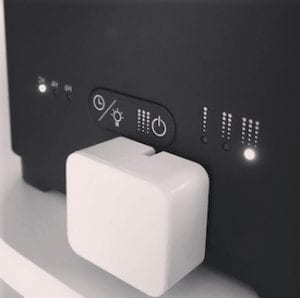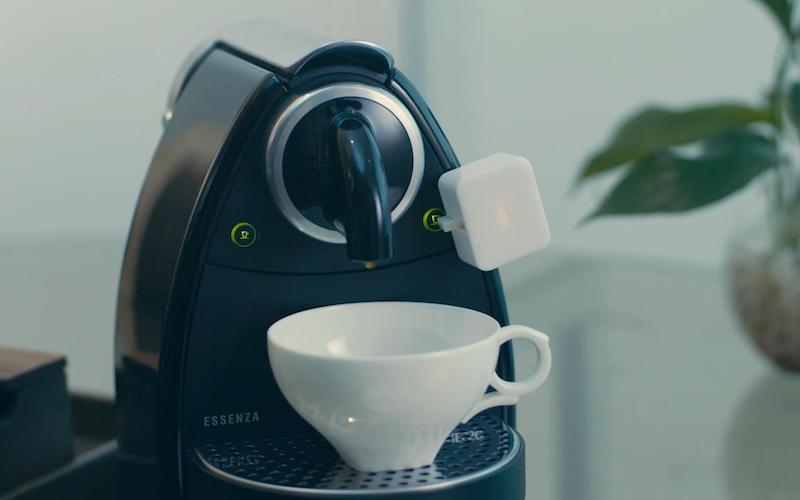Not long ago I wrote briefly about SwitchBots in an article about ways to make your existing appliances smart when you didn’t get a brand new set of smart appliances for the holidays. You can find that article here. When I had a chance to try SwitchBots for myself, I found that they deserved more than the brief mention I gave them.
To review, SwitchBots are small, battery-operated, robotic arms that can be attached to almost any device that is operated by pressing a button. The robotic arm can be triggered to press a button, allowing almost anything to be integrated into a smart home. SwitchBots are attached to devices using 3M, double sided, tape so they can be reused on another device, if desired. And, the replaceable, lithium CR2, battery lasts up to 600 days.
SwitchBots are controlled over a Bluetooth connection using the free, SwitchBot, smartphone app. With the app, up to five separate timers can be configured to operate a SwitchBot at specific times. Alternatively, they can be controlled over Wi-Fi using the optional SwitchBot hub. With the hub, SwitchBots can be controlled with Alexa, Google Assistant, Siri, SmartThings, and IFTTT.
The magic is that SwitchBots are inexpensive; only $29 on Amazon. At this price, existing devices can be integrated into a smart home at a fraction of the price of purchasing a new, smart replacement.
What Can SwitchBot Do?

- If you already own a robot vacuum but it isn’t Wi-Fi connected, then a SwitchBot can be used to start the vacuum’s cleaning cycle when, for example, you leave home. This can be done by integrating a smartphone with IFTTT as a presence sensor and triggering the SwitchBot to press the vacuum’s start button when the homeowner leaves the house with their smartphone.
- Many homes have heating/cooling systems that require a proprietary thermostat and cannot be replaced by smart thermostat. SwitchBots can be used in a variety of ways to add smart features to a proprietary thermostat including:
- Setting back the thermostat when the home isn’t occupied;
- Monitoring the temperature in the home, using the SwitchBot Thermometer and Hygrometer, and tuning on the heat should the temperature get too cold and there is risk of frozen pipes.
- Trigger a pod-based coffee maker to make a cup of coffee when an Alexa device, being used as an alarm clock, wakes up the homeowner in the morning. This can be accomplished by integrating the Alexa IFTTT channel with SwitchBot’s IFTTT channel.
- Many people want to control their smart homes with voice commands but also want to assure their privacy. SwitchBots could be placed on Amazon Echoes in a home to press their mute button when privacy is desired. Triggering these SwitchBots a second time un-mutes the Amazon Echoes.
- While SwitchBots can be used to automate a paddle style light switch, simply replacing the existing switch with a smart one makes more sense. Many smart light switches cost about the same as a SwitchBot and the result is going to be much more aesthetically pleasing. However, SwitchBots are ideal for making an apartment, or other property you are renting, smart where you can’t replace light switches without violating the rental agreement. SwitchBots can be attached to a paddle style light switch to change it to a smart switch. Then, when the lease is up, they can be removed without damaging the switches.
- SwitchBots can be used to automate the operation of a window air conditioner so it can be turned on when your home is occupied and turned off when it isn’t.
- SwitchBot’s operation (with the optional SwitchBot hub) can be integrated with the company’s Thermometer and Hygrometer. For example, in a vacation home, that isn’t always occupied, the Thermometer and Hygrometer could be used to monitor the temperature in the home and a SwitchBot could be triggered to turn on the heat in the home if the temperature in the home drops and there is risk of a pipe freezing.
- And much more…
I have also seen online comments where people use SwitchBots to automate the operation of devices that shouldn’t be automated without replacing the device with a smart version. For example, a SwitchBot could be used to press the button that opens/closes a motorized garage door. This is very unsafe. A garage door opener is supposed to have an auto-reverse, safety feature that keeps it from hurting someone if it closes on them. However, closing a garage door, when nobody is physically present could result in a tragedy if the door closes on a child and the auto-reverse isn’t adjusted properly. Smart garage door operators have built in audible and visual alarms that sound when the garage door is closed remotely to minimize this risk.
Hands on with SwitchBots
The first thing to remember is that SwitchBots are small, battery-operated devices that can only generate a limited amount of force to press a button. According to the SwitchBot website they can generate 1.0kgf of torque strength. I didn’t have a force gauge to validate this but I did see some comments online that it was closer to .8kgf. In any case the take home message is that there is a limit to the force that a SwitchBot to generate. It can press the button on a standard, paddle style, light switch but don’t expect a lot more.
It is also important to mention that SwitchBots needs a flat area approximately, ¾” x 1-½”, for the 3M adhesive pad to adhere to. Not every switch you might want to automate has this available. It may require some creativity to secure a SwitchBot to the device you want to automate if its surface is curved.
The good news is that SwitchBots do exactly what they are designed to do. They provide a reliable solution for pressing buttons to automated older, dumb, devices. When used with the optional SwitchBot hub, the app allows a homeowner to create scenes where:
- Rules can be defined to trigger SwitchBots based on readings from a Thermometer and Hygrometer;
- Multiple SwitchBots can be operated based on a single trigger;
- SwitchBots can be operated based on a schedule;
- Operating times for a scene can be defined such as only allowing a scene that operates light switches to turn the switches on at night.
The only problem I encountered, when working with the evaluation kit that SwitchBot provided me with, was during initial setup of a new SwitchBot. If I connected to a new SwitchBot over Bluetooth, using the SwitchBot app on my phone, I found I couldn’t connect that SwitchBot to the cloud using the SwitchBot hub. Restarting the SwitchBot app fixed this issue. This was a very minor annoyance that was quickly worked around.
There are a few areas where I feel the SwitchBot could be improved:
- It is a challenge to use a SwitchBot with a device that requires multiple button presses. For example, using SwitchBots to lower/raise your thermostat’s set point when you leave, and then later arrive, home is not easy to do because you can’t define a scene with multiple presses by the same SwitchBot. On most thermostats to adjust the set point, for example, by five degrees requires pressing the raise, or lower button, five times. To automate this would require a smart home hub, connected to IFTTT, to trigger the IFTTT applet five separate times, to send five separate press commands to the SwitchBot. A better approach would be to have the smart home hub trigger the IFTTT applet once. Then the SwitchBot scene triggered by the applet would take care of the multiple button presses. The current design adds a degree of complication and timing that SwitchBot should be taking care of for their customers.
- Most cloud services that connect to a hub will send a notification to the homeowner if the hub goes offline. Unfortunately, this isn’t the case with the SwitchBot cloud service and hub. If you are protecting your home from freezing pipes using a SwitchBot attached to your thermostat, as I described earlier, and your hub goes offline, then your pipes could freeze because the SwitchBot’s link to IFTTT isn’t operational. A notification when there is an issue with a hub keeps the SwitchBot from being a system you can trust for critical operations in your home.
- I would like to see the ability to plug wired sensors into the Thermometer and Hygrometer so the device could be used to monitor the conditions inside a refrigerator, freezer, or other environmentally controlled enclosure where the enclosure could block the devices Bluetooth communications.
- Finally, I would also like to see the ability to power both the SwitchBot and the Thermometer and Hygrometer with a wired connection to a plug-in power supply. In most cases a battery is more convenient but if used in a critical operation to protect a home then a wired power connection, backed up by a battery, is more reliable.
Overall the SwitchBot is an inexpensive, easy to use, valuable problem solver when trying to make an existing home smart. Like duct tape, SwitchBot aren’t fancy but solve a multitude of problems.






![ecobee premium airzone control The ecobee Smart Thermostat Premium. [Photo credit | ecobee]](https://restechtoday.com/wp-content/uploads/2025/06/ecobee-premium.jpg)
![Hub 3_02 The SwitchBot Hub 3 provides a user-friendly solution to the growing complexity of modern smart homes. [Photo credit | SwitchBot]](https://restechtoday.com/wp-content/uploads/2025/06/Hub-3_02-scaled-e1750179791687.png)
